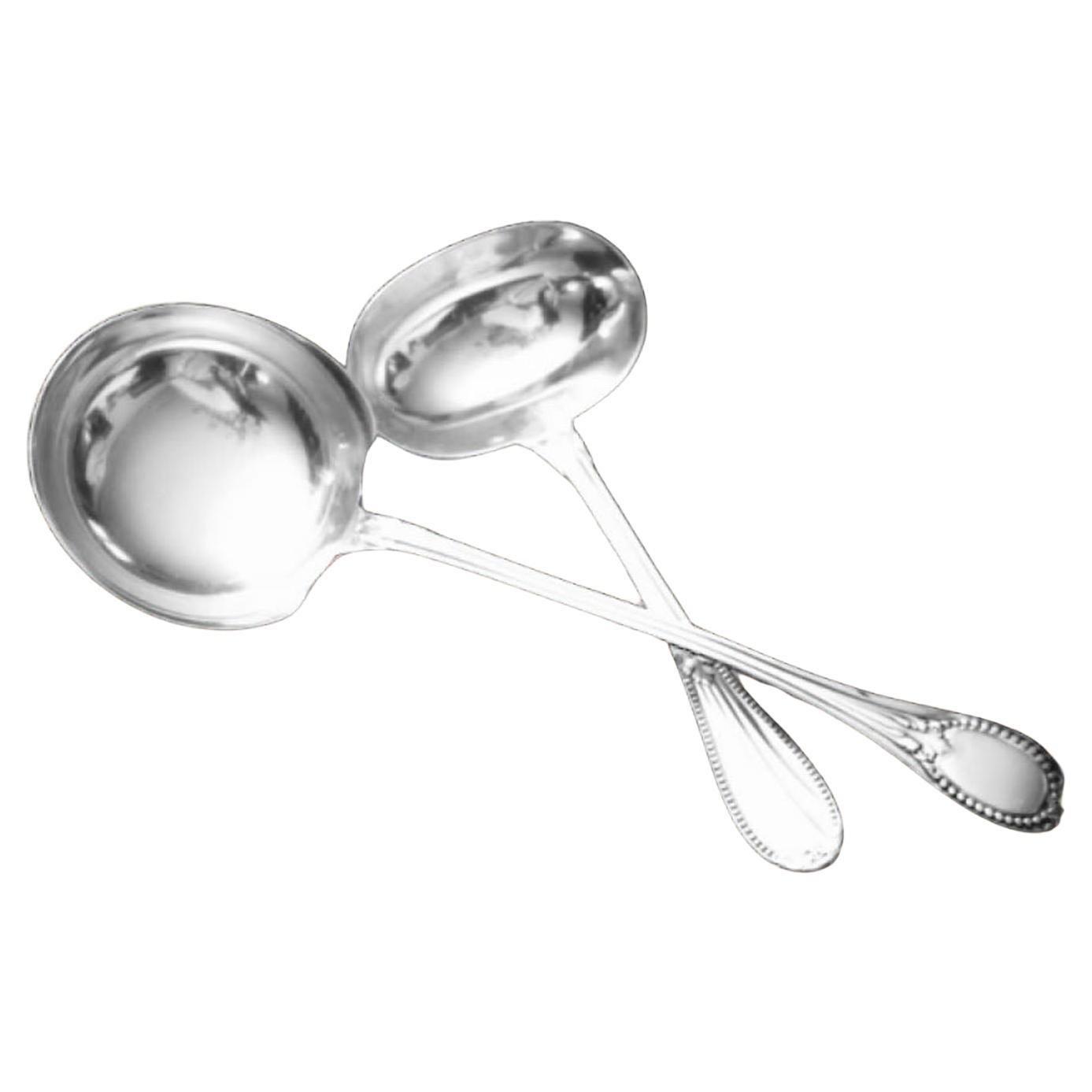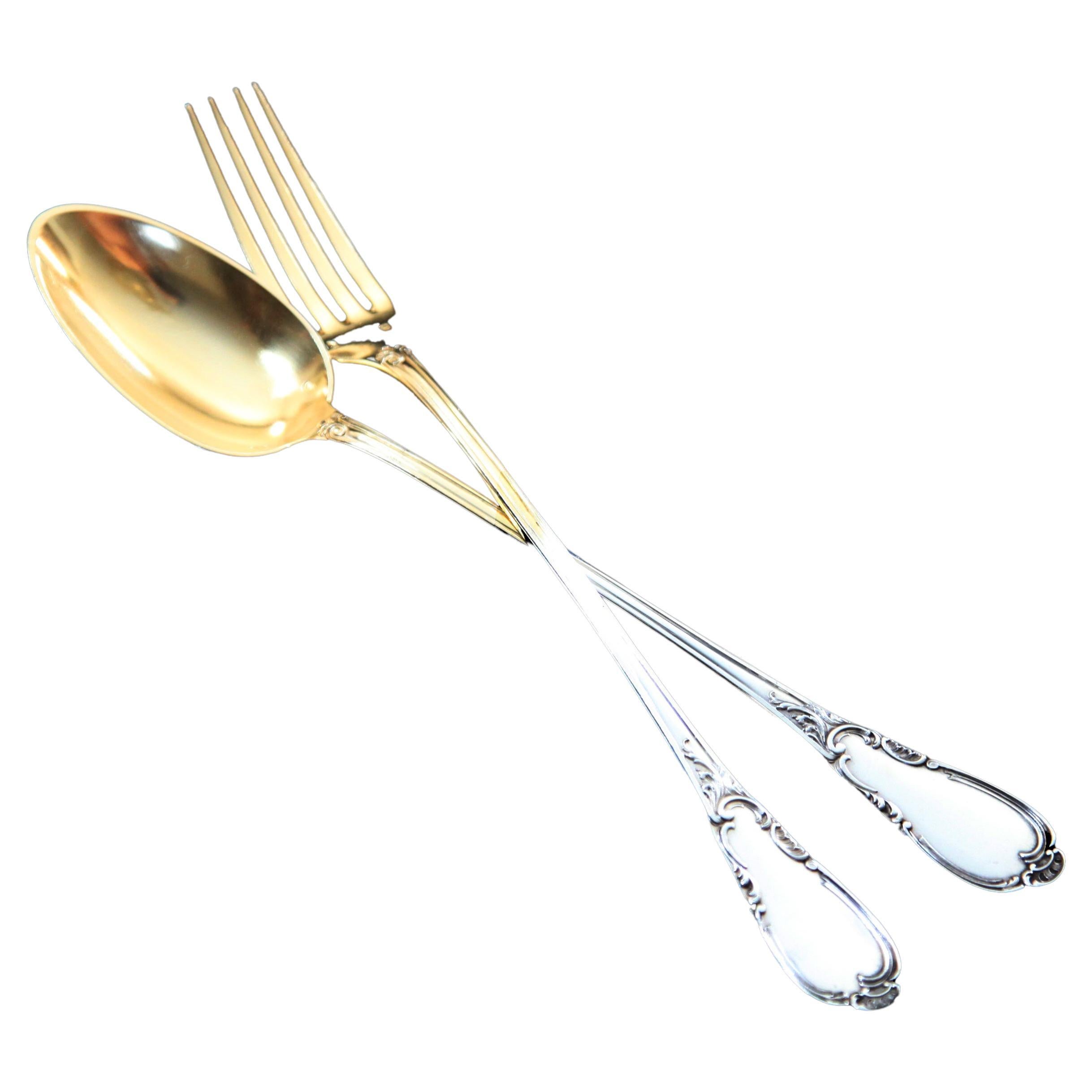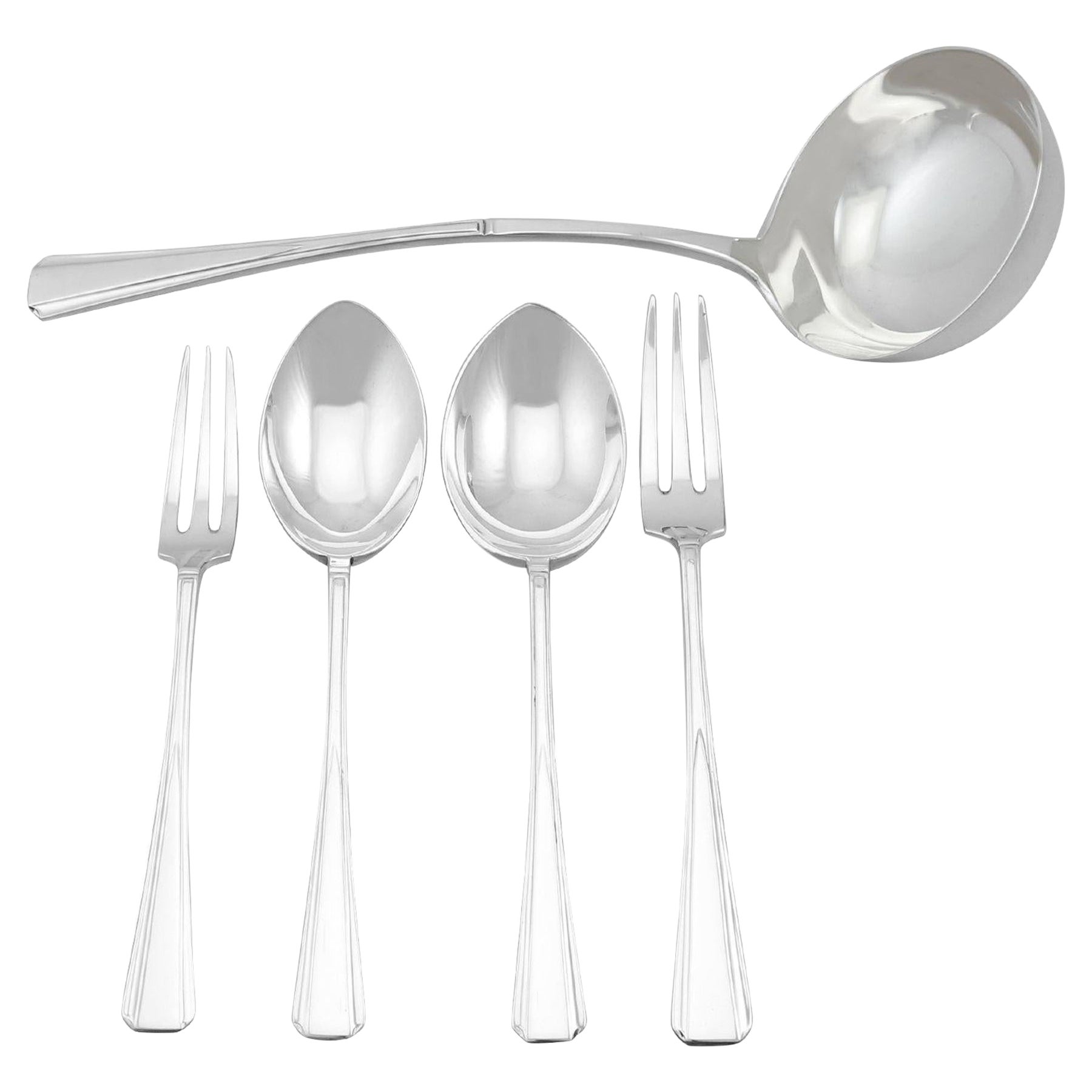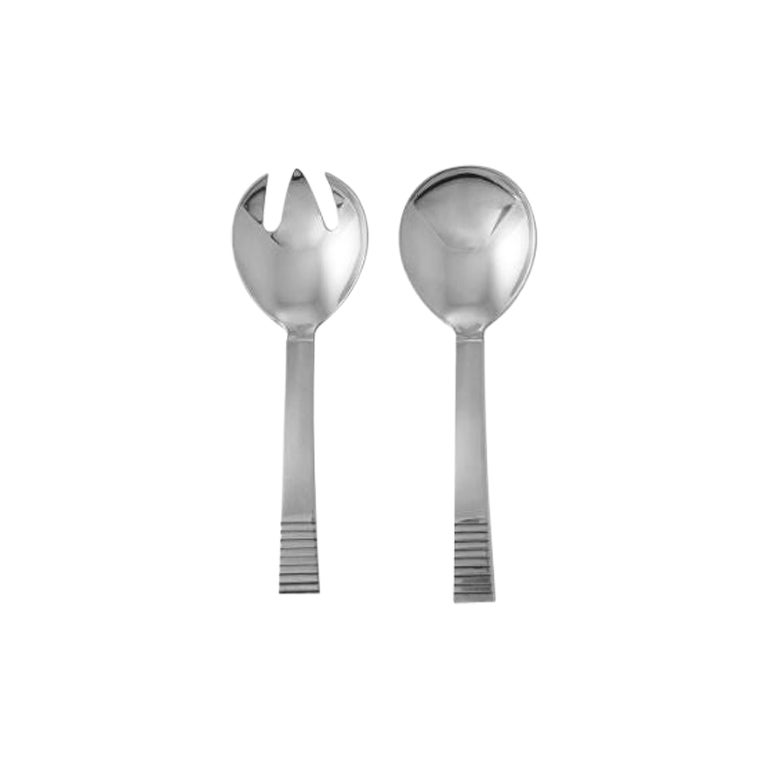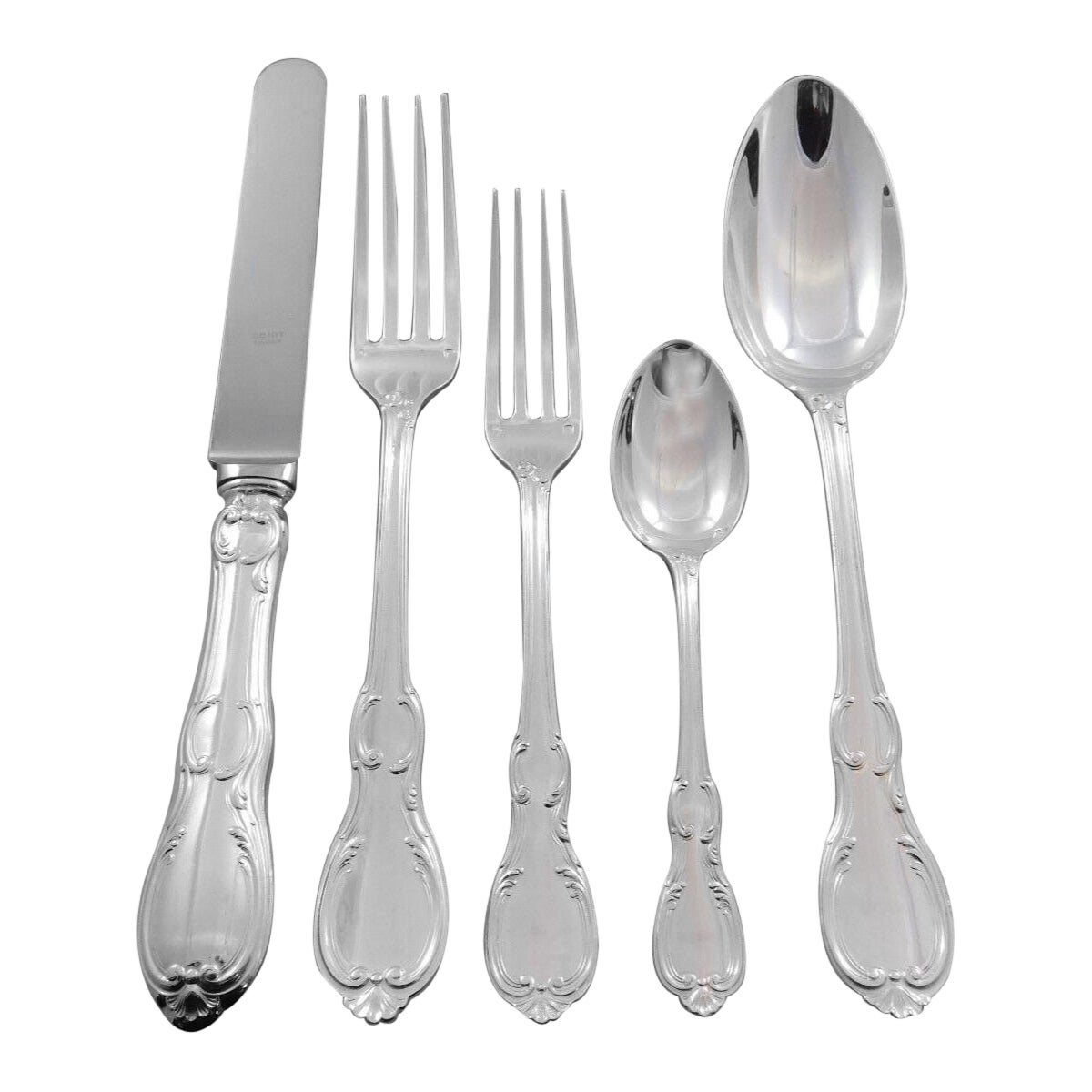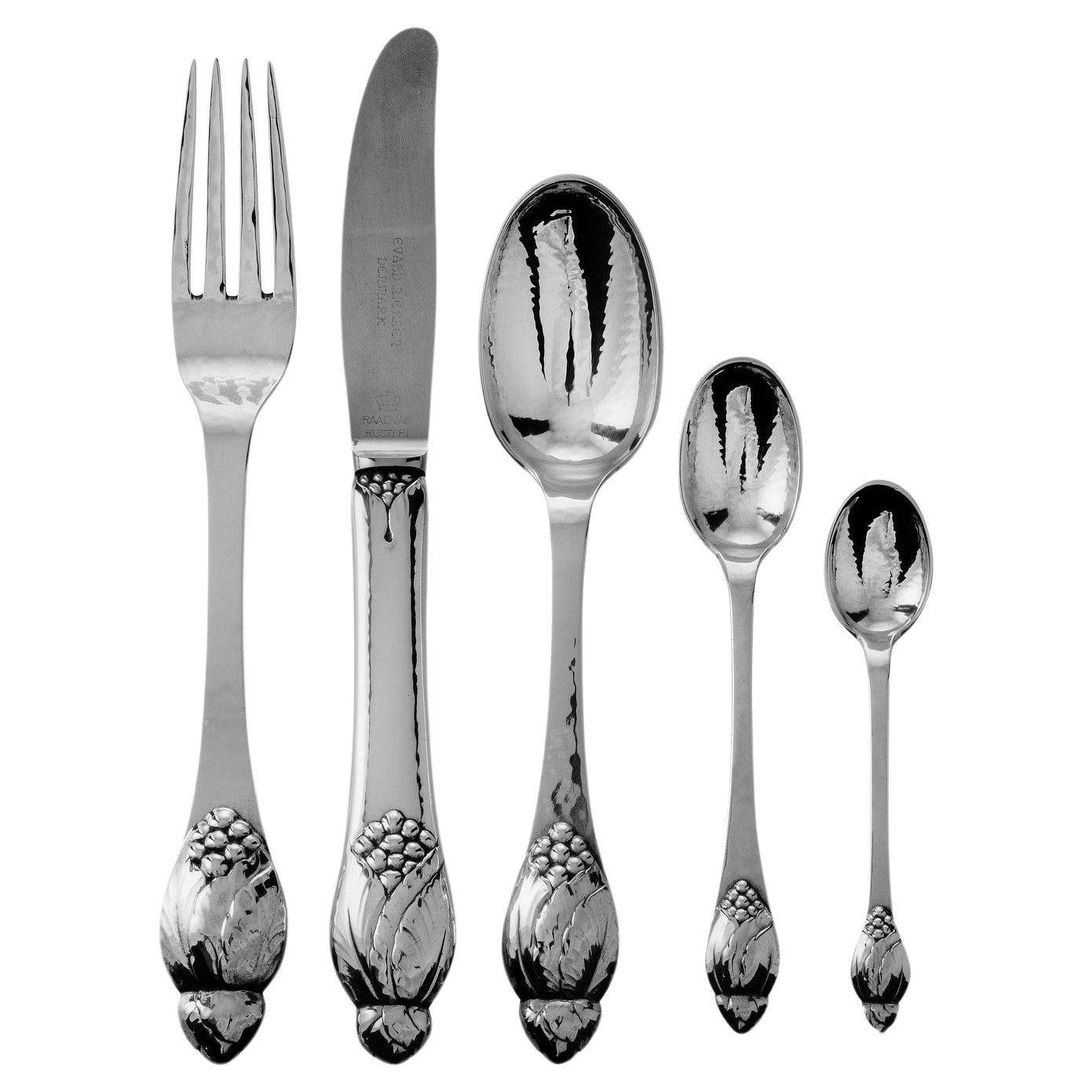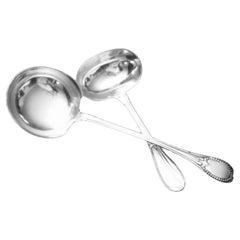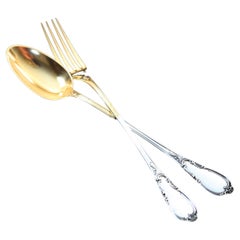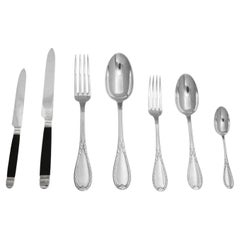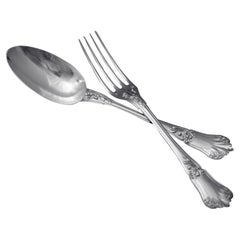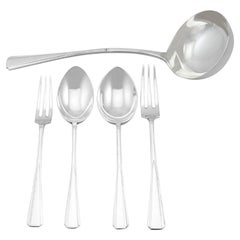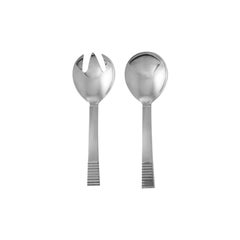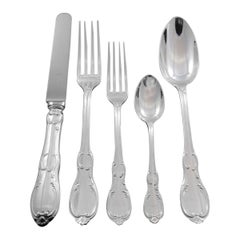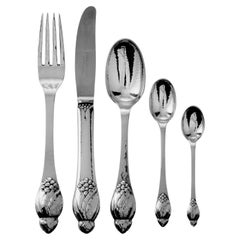Items Similar to Ravinet Denfert - 17pc. Art Deco French 950 Sterling Silver Serving Pieces, MINT
Want more images or videos?
Request additional images or videos from the seller
1 of 17
Ravinet Denfert - 17pc. Art Deco French 950 Sterling Silver Serving Pieces, MINT
$5,099per set
£3,845.15per set
€4,447.10per set
CA$7,153.87per set
A$7,951.97per set
CHF 4,168.25per set
MX$97,112.80per set
NOK 52,038.23per set
SEK 48,958.27per set
DKK 33,191.88per set
About the Item
Direct from Paris the Birth place of Art Deco A Magnificent 17pc. Set of Gatsby Era 950 Sterling Silver Flatware Serving Pieces in Excellent Condition France's Premier Art Deco Silversmiths "Ravinet d'Enfert" and No Monograms, circa 1920s. The Art Deco movement, prominent in the early 20th century, was characterized by its emphasis on modernism, luxury, and craftsmanship. Within this movement, the works of Ravinet d’Enfert, a distinguished French silversmith renowned for their exquisite Art Deco flatware sets, stand out as exemplars of the era's aesthetic and technical innovation.
The Art Deco movement emerged in the aftermath of World War I, flourishing throughout the 1920s and 1930s. It represented a break from the ornate styles of the past, such as Art Nouveau, embracing instead geometric shapes, sleek lines, and a focus on modern materials like glass, chrome, and steel. The movement encompassed various art forms, including architecture, fashion, visual arts, and decorative arts, with each discipline contributing to its distinctive aesthetic. Art Deco was not only a reflection of changing artistic tastes but also of broader societal shifts. It mirrored the optimism and dynamism of the post-war period, as well as the increasing industrialization and urbanization of the Western world. Moreover, it served as a symbol of luxury and sophistication, appealing to the wealthy elite who sought to display their status through elegant and innovative design.
Ravinet d’Enfert, comprised of partners Charles Ravinet and Charles D’Enfert, was a leading figure in the world of French silver-smithing during the Art Deco era. Founded in Paris in the early 20th century, the firm quickly gained renown for its exquisite craftsmanship and avant-garde designs. Ravinet d’Enfert's creations epitomized the principles of Art Deco, featuring bold geometric patterns, streamlined forms, and luxurious materials. The partnership between Ravinet and d’Enfert was instrumental in the success of their enterprise. Both craftsmen brought complementary skills to the table, with Ravinet's expertise lying in design and aesthetics, while d’Enfert excelled in the technical aspects of silver-smithing. Together, they forged a collaborative partnership that allowed them to push the boundaries of their craft and produce works of unparalleled beauty and innovation.
One measure of Ravinet d’Enfert's prestige and reputation was the patronage it received from royalty and aristocracy. Members of European royal families, as well as wealthy industrialists and socialites, coveted the firm's creations for their palaces, mansions, and personal collections. The endorsement of such influential clients not only boosted the firm's profile but also underscored the exceptional quality and desirability of its products. Among Ravinet d’Enfert's notable royal patrons was Queen Marie of Romania, who commissioned several pieces for her residence in Bucharest. The firm also received commissions from other European monarchs, including King Alfonso XIII of Spain and King Gustaf V of Sweden, further solidifying its status as a purveyor of choice for the elite.
In addition to royal patronage, Ravinet d’Enfert counted numerous celebrities and tastemakers among its clientele. From Hollywood stars to prominent artists and intellectuals, the firm's creations found favor with individuals who appreciated the marriage of artistry and functionality embodied in Art Deco design.
The exceptional quality of Ravinet d’Enfert's work was acknowledged through numerous awards and accolades. The firm participated in prestigious exhibitions and competitions, where its pieces consistently garnered praise from critics and connoisseurs alike. These accolades served as a testament to the mastery of craftsmanship and innovation displayed by Ravinet d’Enfert's artisans. One of the most significant honors bestowed upon the firm was the Grand Prix at the 1925 International Exposition of Modern Industrial and Decorative Arts in Paris. This event, which gave rise to the term "Art Deco," showcased the best examples of contemporary design from around the world. Ravinet d’Enfert's victory in this highly competitive arena cemented its reputation as a leading exponent of the movement.
In addition to international recognition, Ravinet d’Enfert received accolades from professional associations and guilds within the silver-smithing community. These awards not only affirmed the firm's position within the industry but also served as a source of pride for its craftsmen, who took great satisfaction in their contribution to the art form.
At the heart of Ravinet d’Enfert's success lay its unwavering commitment to quality and craftsmanship. Each piece produced by the firm was a testament to the skill and dedication of its artisans, who employed traditional techniques alongside modern innovations to achieve unparalleled levels of excellence. Central to Ravinet d’Enfert's approach was a reverence for materials and a meticulous attention to detail. Silver, the primary medium of the firm's creations, was transformed into objects of beauty through a combination of forging, chasing, and engraving techniques. The result was not merely utilitarian objects but works of art that transcended their functional purpose. The firm's designs were characterized by their striking aesthetic and innovative use of form. Drawing inspiration from sources as diverse as ancient civilizations, modern machinery, and natural forms, Ravinet d’Enfert's artisans created pieces that were both timeless and contemporary. Whether in the clean lines of a cocktail shaker or the intricate filigree of a serving tray, each design bore the unmistakable stamp of Art Deco elegance.
Equally noteworthy was the practicality and functionality inherent in Ravinet d’Enfert's designs. While many Art Deco objects were admired for their visual appeal, they were also intended to be used and enjoyed in everyday life. Ravinet d’Enfert struck a delicate balance between form and function, ensuring that its flatware sets were not only aesthetically pleasing but also eminently practical. Despite the passage of time, the allure of Ravinet d’Enfert's Art Deco flatware sets endures. Revered for their timeless elegance and impeccable craftsmanship, these pieces continue to captivate collectors and connoisseurs alike. Today, Ravinet d’Enfert flatware sets are sought after as prized heirlooms and cherished additions to fine dining collections.
The enduring popularity of Ravinet d’Enfert's Art Deco flatware sets can be attributed to several factors. Firstly, their timeless design aesthetic transcends the boundaries of passing trends, ensuring their relevance across generations. Secondly, the exceptional quality of craftsmanship imbues these pieces with a sense of luxury and prestige, making them highly desirable among discerning collectors. Lastly, the historical significance of Ravinet d’Enfert as a pioneering figure in the Art Deco movement adds to the intrinsic value of its flatware sets, elevating them to iconic status within the realm of decorative arts.
This magnificent set of 17 flatware serving pieces is in near new condition and is a stunning example of the excellence of workmanship and quality for which the firm was known. Each piece in this magnificent set bears the French Government's Head of the Minerva 1 Hallmark certifying a minimum of 950 sterling silver in addition to the Ravinet d'Enfert sterling silver manufacturer's hallmark and includes the following (all weights and measures approximate):
1 Large Serving Spoon 25.00 cm. 137 grams
1 Salad Serving Fork 25.00 cm. 120 grams
1 Salad Serving Spoon 25.00 cm. 112 grams
1 Fish Serving Fork 22.50 cm. 124 grams
1 Fish Serving Knife 26.50 cm. 135 grams
1 Meat Serving Fork 27.20 cm. 143 grams
1 Meat Serving Knife - Stainless Steel Blade 29.20 cm. 113 grams
1 Large Soup / Stew Serving Ladle 31.30 cm. 236 grams
1 Ice Cream Scoop 23.50 cm. 120 grams
1 Cake / Pie Serving Knife 27.50 cm. 134 grams
1 Sauce Serving Ladle 23.00 cm. 94 grams
1 Berry Serving Spoon 15.80 cm. 45 grams
1 Gravy Serving Ladle 17.00 cm. 80 grams
1 Dainty "bonbon" Serving Knives 15.70 cm. 80 grams
1 Dainty "bonbon" Serving Fork 13.70 cm. 27 grams
1 Dainty "bonbon" Server 13.00 cm. 31 grams
1 Olive Serving Spoon 13.70 cm. 29 grams
- Creator:Ravinet D' Enfert (Designer)
- Sold As:Set of 17
- Style:Art Deco (Of the Period)
- Materials and Techniques:
- Place of Origin:
- Period:
- Date of Manufacture:1920s
- Condition:Refinished. Each of the 17 pieces has been professionally refinished to near new condition.
- Seller Location:Wilmington, DE
- Reference Number:1stDibs: LU9583238805952
About the Seller
No Reviews Yet
Vetted Professional Seller
Every seller passes strict standards for authenticity and reliability
1stDibs seller since 2023
6 sales on 1stDibs
- ShippingRetrieving quote...Shipping from: Paris, France
- Return Policy
Authenticity Guarantee
In the unlikely event there’s an issue with an item’s authenticity, contact us within 1 year for a full refund. DetailsMoney-Back Guarantee
If your item is not as described, is damaged in transit, or does not arrive, contact us within 7 days for a full refund. Details24-Hour Cancellation
You have a 24-hour grace period in which to reconsider your purchase, with no questions asked.Vetted Professional Sellers
Our world-class sellers must adhere to strict standards for service and quality, maintaining the integrity of our listings.Price-Match Guarantee
If you find that a seller listed the same item for a lower price elsewhere, we’ll match it.Trusted Global Delivery
Our best-in-class carrier network provides specialized shipping options worldwide, including custom delivery.More From This Seller
View AllRoussel - 22 Sterling Silver 19th Century Louis XVI Flatware Serving Pieces
By Claude Doutre Roussel
Located in Wilmington, DE
Direct from Paris, a stunning set of 22 sterling silver, 19th century, Louis XVI, flatware serving pieces by Master French Silversmith Claude Doutre Roussel in excellent condition an...
Category
Antique Late 19th Century French Louis XVI Serving Pieces
Materials
Sterling Silver
Jean Granvigne - 20 Antique French Art Nouveau Sterling Serving Pieces - 1890s
By J. Granvigne
Located in Wilmington, DE
Direct from Paris, a Magnificent Set of 20 Louis XVI Flatware Serving Pieces in French 950 Sterling Silver by Internationally Known French Silversmi...
Category
Antique Late 19th Century French Art Nouveau Serving Pieces
Materials
Vermeil, Sterling Silver
$3,149 Sale Price / set
25% Off
Free Shipping
Lapparra - 111pc., Antique French Sterling Silver Flatware Set - Service for 18
By Lapparra Orfèvre Argentier
Located in Wilmington, DE
Direct from Paris, a magnificent 111pc. sterling silver flatware set by internationally known French silversmith "Lapparra", classic "Louis XVI" pattern with rare ebony handled knive...
Category
Antique Late 19th Century French Louis XVI Sterling Silver
Materials
Sterling Silver
$18,144 / set
Free Shipping
Queille & Soufflot - 37pc. Antique French 19th Century Dessert Flatware Set !
By Pierre François Queille 1, Henri Soufflot 1
Located in Wilmington, DE
Direct from Paris, a stunning 37pc. 19th century, dessert flatware set by two of France’s premier silversmiths “Pierre Queille” and “Henri Soufflot” in excellent condition and includ...
Category
Antique Late 19th Century French Louis XV Sterling Silver
Materials
Sterling Silver
$3,699 / set
Free Shipping
Christofle (Cardeilhac) - 44pc 950 Sterling Silver Flatware Set, Bagatelle Model
By Cardeilhac
Located in Wilmington, DE
Direct from Paris, A Magnificent 44pc. 950 Sterling Silver Louis XVI Flatware "Starter Set" by France's Premier Silversmiths Jacques and Pierre Ca...
Category
Early 20th Century French Art Nouveau Sterling Silver
Materials
Sterling Silver
$9,314 / set
Free Shipping
Puiforcat (Hermes) - 70pc Antique French Sterling Silver Flatware Set + Chests !
By Puiforcat
Located in Wilmington, DE
Direct from Paris, a stunning 70pc. antique French 19th century sterling silver flatware set by France’s premier silversmith “Puiforcat”, currently owned by Hermes, in excellent condition and with individual storage chests. The name Puiforcat resonates deeply within the annals of French luxury, embodying the pinnacle of silversmithing craftsmanship, tradition, and innovation. With a history spanning nearly two centuries, the house of Puiforcat is synonymous with unparalleled quality, royal patronage, and an enduring legacy that seamlessly blends classical elegance with modern artistry. From its foundation in the early 19th century to its contemporary association with the luxury conglomerate Hermès, Puiforcat has maintained its status as a paragon of excellence in the creation of sterling silver flatware and objets d'art.
The story of Puiforcat begins in 1820, when Émile Puiforcat established the silversmithing company in Paris. Initially focused on the production of flatware, the company quickly gained a reputation for its meticulous craftsmanship and exquisite designs. The Puiforcat family, over several generations, maintained a steadfast commitment to the highest standards of silversmithing. Each piece produced by the workshop was meticulously handcrafted, with an attention to detail that elevated Puiforcat above many of its contemporaries. The company’s dedication to quality was not merely about aesthetics; it was a philosophical approach that viewed silversmithing as an art form. Every piece, whether a simple spoon or an ornate candelabra, was treated as a work of art, designed to bring beauty and elegance to everyday life.
Puiforcat’s reputation for excellence did not go unnoticed by the elite of French society. The house soon became a favored silversmith among the aristocracy and royalty, further solidifying its status as a purveyor of luxury. The association with the French royal family was a significant milestone for Puiforcat, as it brought the company into the upper echelons of French society and culture. One of the most notable patrons of Puiforcat was the Duke of Orléans, a member of the Bourbon royal family. The Duke’s patronage was instrumental in elevating Puiforcat’s profile, as it led to commissions for some of the most prestigious households in Europe. These commissions often involved the creation of bespoke pieces that were tailored to the specific tastes and requirements of the clients, showcasing Puiforcat’s ability to blend traditional craftsmanship with personalized design. The royal patronage extended beyond France’s borders as well, with Puiforcat receiving commissions from various European courts. This international recognition helped the company to expand its influence and cement its position as one of the leading silversmiths in Europe. The ability to cater to such discerning clients required not only exceptional craftsmanship but also an understanding of the cultural and aesthetic nuances that defined different European courts. Puiforcat’s success in this regard is a testament to the company’s versatility and artistic sensibility.
At the heart of Puiforcat’s enduring appeal is its commitment to creating the finest sterling silver flatware in the world. The company’s 950 sterling silver flatware sets are considered some of the best in the industry, renowned for their exceptional quality, durability, and timeless beauty. Sterling silver is an alloy consisting of 92.5% pure silver and 7.5% other metals, typically copper. However, Puiforcat goes a step further by using 950 sterling silver, which contains 95% pure silver. This higher silver content gives the flatware a more luminous finish and a greater resistance to tarnishing, making it ideal for both everyday use and special occasions. The process of creating Puiforcat’s sterling silver flatware is a labor-intensive one, requiring the skill and expertise of master silversmiths. Each piece is handcrafted using traditional techniques that have been passed down through generations. This includes the meticulous process of shaping, hammering, and polishing the silver to achieve the desired form and finish. The attention to detail is evident in every aspect of the flatware, from the perfectly balanced weight to the intricate engravings that adorn many of the pieces.
One of the hallmarks of Puiforcat’s flatware...
Category
Antique Late 19th Century French Sterling Silver
Materials
Sterling Silver
$20,955 / set
Free Shipping
You May Also Like
Vintage Art Deco Sterling Silver Canteen of Cutlery for Twelve Persons
By Ollivant & Botsford
Located in Jesmond, Newcastle Upon Tyne
An exceptional, fine and impressive vintage sterling silver Plain Pine pattern flatware service for twelve persons, in the Art Deco style; an addition to our canteen of cutlery collection.
The pieces of this exceptional vintage George VI silver flatware service for 12 persons have been crafted in the Plain Pine pattern.
The plain tapering handle of each piece is embellished with Art Deco style geometric panelled decoration with a stepped-down top.
The posterior surface of each handle is ornamented with a triangular panel to the terminal.
The original sterling silver forks have three tines/prongs; this is a fine feature of the service.
This vintage Art Deco flatware set consists of 43 pieces:
The components of this service have been crafted by the Sheffield silversmith and flatware maker Ollivant & Botsford Ltd between 1937-1941; the pieces will have been crafted in less years but due to the hallmarking system the items are struck with the date letters u and y.
This vintage silver service can be purchased with appropriate pattern knives if so desired; for further information please contact Andrew Campbell directly.
These impressive examples of Art Deco silverware are supplied in felt cutlery rolls; which not only protect the items in storage but significantly reduces tarnishing.
Condition
This vintage silver canteen set...
Category
20th Century English Art Deco Tableware
Materials
Silver, Sterling Silver
Set of Georg Jensen Sterling Silver Parallel Jam, Items 163/164
By Oscar Gundlach-Pedersen
Located in Hellerup, DK
A vintage sterling silver Georg Jensen jam set, items #163 & #164 in the Parallel pattern, design #25 by Oscar Gundlach-Pedersen from 1931. The Parallel design has an exceptional dig...
Category
20th Century Danish Art Deco Tableware
Materials
Sterling Silver
Penthievre by Odiot France 950 Sterling Silver Flatware Set Service 61 Pc Dinner
By Odiot
Located in Big Bend, WI
Founded in 1690, the House of Odiot gained prominence through prestigious commissions from Emperor Napoleon and his family, which in turn led to orders from all the courts of Europe. Every piece of Odiot silver is entirely hand made to order in France. Odiot collections can be found in many of the most prestigious museums in the world.
Outstanding Penthievre by Odiot France 950 sterling...
Category
20th Century Sterling Silver
Materials
Sterling Silver
30 Pieces Set of Evald Nielsen Sterling Silver No.6 Silverware
By Evald Nielsen
Located in Hellerup, DK
A vintage silverware service for six persons, designed and produced by Copenhagen silversmith Evald Nielsen, this pattern is No. 6. Evald Nielsen was a contemporary of Georg Jensen a...
Category
Vintage 1930s Danish Art Nouveau Tableware
Materials
Sterling Silver
92 Pieces Set of Hans Hansen Sterling Silverware Service in Baronet Pattern
Located in Hellerup, DK
This is a sterling silver Hans Hansen silverware service for 12 in the Baronet pattern (Danish name Arvesølv #7). Each setting comprises 7 pieces, plus serving pieces.
This set incl...
Category
Vintage 1940s Unknown Art Deco Tableware
Materials
Sterling Silver
Eight F&K Serving Parts in Plated Silver, 1930s
Located in København, Copenhagen
Eight F&K Friedman & Kemeney serving parts in plated silver, 1930s.
Largest part measures: 25.3 cm.
In very good condition.
Stamped.
With monogram.
Category
Vintage 1930s American Art Deco Tableware
Materials
Silver Plate
More Ways To Browse
Sterling Silver Spain
French 950 Silver
French Silver Minerva
Art Deco Knives
Art Nouveau Fork
Silver Fork Art Nouveau
Sterling Silver Serving Trays
Arts And Crafts Flatware
Design Guild Glass
Antique French Knives
Art Deco Serving Spoon
Art Deco Server
Chrome Art Deco Display
European Silver Flatware
Romania Glass
Knife Display
Art Deco Revere
Antique Silver Sauce Ladle
